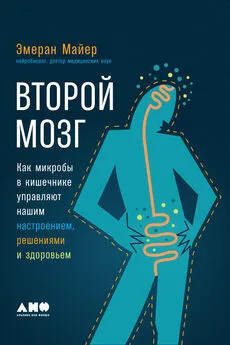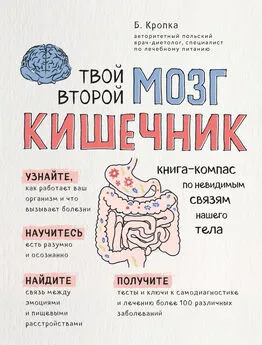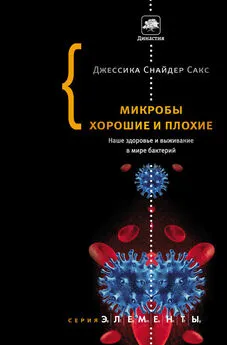Эмеран Майер - Второй мозг: Как микробы в кишечнике управляют нашим настроением, решениями и здоровьем
- Название:Второй мозг: Как микробы в кишечнике управляют нашим настроением, решениями и здоровьем
- Автор:
- Жанр:
- Издательство:Альпина нон-фикшн
- Год:2018
- Город:Москва
- ISBN:978-5-9614-5266-2
- Рейтинг:
- Избранное:Добавить в избранное
-
Отзывы:
-
Ваша оценка:
Эмеран Майер - Второй мозг: Как микробы в кишечнике управляют нашим настроением, решениями и здоровьем краткое содержание
Доктор медицинских наук Эмеран Майер представляет в своей книге революционный взгляд на устройство человеческого организма и на то, какую роль в нем играет взаимодействие между головным мозгом и желудочно-кишечным трактом. Триллионы микроорганизмов, обитающих в кишечнике, находятся в постоянной связи друг с другом и с головным мозгом, и именно от нее во многом зависит и наше общее состояние, и даже принятие жизненных решений.
Кроме того, сбои в этом взаимодействии ведут к развитию депрессии, аутизма, деменции и болезни Паркинсона.
Автор убедительно показывает, что здоровье организма и борьба с серьезными хроническими заболеваниями невозможны без налаживания правильного диалога со своими микробами.
Второй мозг: Как микробы в кишечнике управляют нашим настроением, решениями и здоровьем - читать онлайн бесплатно ознакомительный отрывок
Интервал:
Закладка:
Hamilton, M. Kristina, Gaëlle Boudry, Danielle G. Lemay, and Helen E. Raybould. “Changes in Intestinal Barrier Function and Gut Microbiota in High-Fat Diet-Fed Rats Are Dynamic and Region Dependent.” American Journal of Physiology — Gastrointestinal and Liver Physiology 308 (2015): G840–51.
Henry J. Kaiser Family Foundation. “Health Care Costs: A Primer. How Much Does the US Spend on Health Care and How Has It Changed.” May 1, 2012. http://kff.org/report-section/health-care-costs-a-primer-2012-report/.
— —. “Snapshots: Health Care Spending in the United States and Selected OECD Countries.” April 12, 2011. http://kff.org/health-costs/issue-brief/snapshots-health-care-spending-in-the-united-states-selected-oecd-countries/.
Hildebrandt, Marie A., Christian Hoffman, Scott A. Sherrill-Mix, Sue A. Keilbaugh, Micah Hamady, Ying-Yu Chen, Rob Knight, Rexford S. Ahima, Frederic Bushman, and Gary D. Wul. “High-Fat Diet Determines the Composition of the Murine Gut Microbiome Independently of Obesity.” Gastroenterology 137 (2009): 1716–24.e1–2.
House, Patrick K., Ajai Vyas, and Robert Sapolsky. “Predator Cat Odors Activate Sexual Arousal Pathways in Brains of Toxoplasma gondii Infected Rats.” PLoS One 6 (2011): e23277.
Hsiao, Elaine Y. “Gastrointestinal Issues in Autism Spectrum Disorder.” Harvard Review of Psychiatry 22 (2014): 104–11.
Human Microbiome Consortium. “A Framework for Human Microbiome Research.” Nature 486 (2012): 215–21.
Iwatsuki, Ken, R. Ichikawa, A. Uematsu, A. Kitamura, H. Uneyama, and K. Torii. “Detecting Sweet and Umami Tastes in the Gastrointestinal Tract.” Acta Physiologica (Oxford) 204 (2012): 169–77.
Jaenig, Wilfrid. The Integrative Action of the Autonomic Nervous System: Neurobiology of Homeostasis. Cambridge: Cambridge University Press, 2006.
Jasarevic, Eldin, Ali B. Rodgers, and Tracy L. Bale. “Alterations in the Vaginal Microbiome by Maternal Stress Are Associated with Metabolic Reprogramming of the Offspring Gut and Brain.” Endocrinology 156 (2015): 3265–76.
— —. “A Novel Role for Maternal Stress and Microbial Transmission in Early Life Programming and Neurodevelopment.” Neurobiology of Stress 1 (2015): 81–88.
Johnson, Pieter T. J., Jacobus C. de Roode, and Andy Fenton. “Why Infectious Disease Research Needs Community Ecology.” Science 349 (2015): 1259504.
Jouanna, Jacques. Hippocrates. Baltimore: Johns Hopkins University Press, 1999.
Karamanos, B., A. Thanopoulou, F. Angelico, S. Assaad-Khalil, A. Barbato, M. Del Ben, V. Dimitrijevic-Sreckovic, et al. “Nutritional Habits in the Mediterranean Basin: The Macronutrient Composition of Diet and Its Relation with the Traditional Mediterranean Diet: Multi-Centre Study of the Mediterranean Group for the Study of Diabetes (MGSD).” European Journal of Clinical Nutrition 56 (2002): 983–91.
Kastorini, Christina-Maria, Haralampos J. Milionis, Katherine Esposito, Dario Giugliano, John A. Goudevenos, and Demosthenes B. Panagiotakos. “The Effect of Mediterranean Diet on Metabolic Syndrome and Its Components: A Meta-Analysis of 50 Studies and 534,906 Individuals.” Journal of the American College of Cardiology 57 (2011): 1299–1313.
Koenig, Jeremy E., Aymé Spor, Nicholas Scalfone, Ashwana D. Fricker, Jesse Stombaugh, Rob Knight, Largus T. Angenent, and Ruth E. Ley. “Succession of Microbial Consortia in the Developing Infant Gut Microbiome.” Proceedings of the National Academy of Sciences USA 108 Suppl 1 (2011): 4578–85.
Krol, Kathleen M., Purva Rajhans, Manuela Missana, and Tobias Grossmann. “Duration of Exclusive Breastfeeding Is Associated with Differences in Infants’ Brain Responses to Emotional Body Expressions.” Frontiers in Behavioral Neuroscience 8 (2015): 459.
Le Doux, Joseph. The Emotional Brain: The Mysterious Underpinnings of Emotional Life. New York: Simon & Schuster, 1996.
Ley, Ruth E., Catherine A. Lozupone, Micah Hamady, Rob Knight, and Jeffrey I. Gordon. “Worlds Within Worlds: Evolution of the Vertebrate Gut Microbiota.” Nature Reviews Microbiology 6 (2008): 776–88.
Lizot, Jacques. Tales of the Yanomami: Daily Life in the Venezuelan Forest. Cambridge: Cambridge University Press, 1991.
Lopez-Legarrea, Patricia, Nicholas Robert Fuller, Maria Angeles Zulet, Jose Alfredo Martinez, and Ian Douglas Caterson. “The Influence of Mediterranean, Carbohydrate and High Protein Diets on Gut Microbiota Composition in the Treatment of Obesity and Associated Inflammatory State.” Asia Pacific Journal of Clinical Nutrition 23 (2014): 360–68.
Lyte, Mark. “The Effect of Stress on Microbial Growth.” Anima: Health
Research Reviews 15 (2014): 172–74.
Mawe, Gary M., and Jill M. Hoffman. “Serotonin Signaling in the Gut: Functions, Dysfunctions, and Therapeutic Targets.” Nature Reviews Gastroenterology and Hepatology 10 (2013): 473–86.
Mayer, Emeran A. “Gut Feelings: The Emerging Biology of Gut-Brain Communication.” Nature Reviews Neuroscience 12 (2011): 453–66.
— —. “The Neurobiology of Stress and Gastrointestinal Disease.” Gut 47 (2000): 861–69.
Mayer, Emeran A., and Pierre Baldi. “Can Regulatory Peptides Be Regarded as Words of a Biological Language.” American Journal of Physiology 261 (1991): G171–84.
Mayer, Emeran A., Rob Knight, Sarkis K. Mazmanian, John F. Cryan, and Kirsten Tillisch. “Gut Microbes and the Brain: Paradigm Shift in Neuroscience .” Journal of Neuroscience 34 (2014): 15490–6.
Mayer, Emeran A., Bruce D. Naliboff, Lin Chang, and Santosh V. Coutinho. “V. Stress and Irritable Bowel Syndrome.” American Journal of Physiology — Gastrointestinal and Liver Physiology 280 (2001): G519–24.
Mayer, Emeran A., Bruce D. Naliboff, and A. D. Craig. “Neuroimaging of the Brain-Gut Axis: From Basic Understanding to Treatment of Functional GI disorders.” Gastroenterology 131 (2006): 1925–42.
Mayer, Emeran A., David Padua, and Kirsten Tillisch. “Altered Brain-Gut Axis in Autism: Comorbidity or Causative Mechanisms?” Bioessays 36 (2014): 933–39.
Mayer, Emeran A., Kirsten Tillisch, and Arpana Gupta. “Gut/Brain Axis and the Microbiota.” Journal of Clinical Investigation 125 (2015): 926–38.
McGovern Institute for Brain Research at MIT. “Brain Disorders by the Numbers.” January 16, 2014. https://mcgovern.mit.edu/brain-disorders/by-the-numbers#AD.
Menon, Vinod, and Luciana Q. Uddin. “Saliency, Switching, Attention and Control: A Network Model of Insula Function.” Brain Structure and Function 214 (2010): 655–67.
Mente, Andrew, Lawrence de Koning, Harry S. Shannon, and Sonia S. Anand. “A Systematic Review of the Evidence Supporting a Causal Link Between Dietary Factors and Coronary Heart Disease.” Archives of Internal Medicine 169 (2009): 659–69.
Moss, Michael. Salt, Sugar, Fat. New York: Random House, 2013.
Pacheco, Alline R., Daniela Barile, Mark A. Underwood, and David A. Mills. “The Impact of the Milk Glycobiome on the Neonate Gut Microbiota.” Annual Review of Animal Biosciences 3 (2015): 419–45.
Panksepp, Jaak. Affective Neuroscience. The Foundations of Human and Animal Emotions. Oxford: Oxford University Press, 1998.
Pelletier, Amandine, Christine Barul, Catherine Féart, Catherine Helmer, Charlotte Bernard, Olivier Periot, Bixente Dilharreguy, et al. “Mediterranean Diet and Preserved Brain Structural Connectivity in Older Subjects.” Alzheimer’s and Dementia 11 (2015): 1023–31.
Pollan, Michael. Food Rules: An Eater’s Manual. New York: Penguin Books, 2009.
Psaltopoulou, Theodora, Theodoros N. Sergentanis, Demosthenes B. Panagiotakos, Ioannis N. Sergentanis, Rena Kosti, and Nikolaos Scarmeas. “Mediterranean Diet, Stroke, Cognitive Impairment, and Depression: A Meta-Analysis.” Annals of Neurology 74 (2013): 580–91.
Psichas, Arianna, Frank Reimann, and Fiona M. Gribble. “Gut Chemosensing Mechanisms.” Journal of Clinical Investigation 125 (2015): 908–17.
Qin, Junjie, Ruiqiang Li, Jeroen Raes, Manimozhiyan Arumugam, Kristoffer Solvsten Burgdorf, Chaysavanh Manichanh, Trine Nielsen, et al. “A Human Gut Microbial Gene Catalogue Established by Metagenomic Sequencing.” Nature 464 (2010): 59–65.
Queipo-Ortuno, Maria Isabel, María Boto-Ordóñez, Mora Murri, Juan Miguel Gomez-Zumaquero, Mercedes Clemente-Postigo, Ramon Estruch, Fernando Cardona Diaz, Cristina Andrés-Lacueva, and Francisco J. Tinahones. “Influence of Red Wine Polyphenols and Ethanol on the Gut Microbiota Ecology and Biochemical Biomarkers.” American Journal of Clinical Nutrition 95 (2012): 1323–34.
Raybould, Helen E. “Gut Chemosensing: Interactions Between Gut Endocrine Cells and Visceral Afferents.” Autonomic Neuroscience 153 (2010): 41–46.
Relman, David A. “The Human Microbiome and the Future Practice of Medicine.” Journal of the American Medical Association 314 (2015): 1127–28.
Rook, Graham A., and Christopher A. Lowry. “The Hygiene Hypothesis and Psychiatric Disorders.” Trends in Immunology 29 (2008): 150–58.
Rook, Graham A., Charles L. Raison, and Christopher A. Lowry. “Microbiota, Immunoregulatory Old Friends and Psychiatric Disorders.” Advances in Experimental Medicine and Biology 817 (2014): 319–56.
Roth, Jesse, Derek LeRoith, E. S. Collier, N. R. Weaver, A. Watkinson, C. F. Cleland, and S. M. Glick. “Evolutionary Origins of Neuropeptides, Hormones, and Receptors: Possible Applications to Immunology.” Journal of Immunology 135 Suppl (1985): 816s — 819s.
Roth, Jesse, Derek LeRoith, Joseph Shiloach, James L. Rosenzweig, Maxine A. Lesniak, and Jana Havrankova. “The Evolutionary Origins of Hormones, Neurotransmitters, and Other Extracellular Chemical Messengers: Implications for Mammalian Biology.” New England Journal of Medicine 306 (1982): 523–27.
Rutkow, Ira M. “Beaumont and St. Martin: A Blast from the Past.” Archives of Surgery 133 (1998): 1259.
Sanchez, M. Mar, Charlotte O. Ladd, and Paul M. Plotsky. “Early Adverse Experience as a Developmental Risk Factor for Later Psychopathology: Evidence from Rodent and Primate Models.” Development and Psychopathology 13 (2001): 419–49.
Sapolsky, Robert. “Bugs in the Brain.” Scientific American, March 2003, 94.
Scheperjans, Filip, Velma Aho, Pedro A. B. Pereira, Kaisa Koskinen, Lars Paulin, Eero Pekkonen, Elena Haapaniemi, et al. “Gut Microbiota Are Related to Parkinson’s Disease and Clinical Phenotype.” Movement Disorders 30 (2015): 350–58.
Schnorr, Stephanie L., Marco Candela, Simone Rampelli, Manuela Centanni, Clarissa Consolandi, Giulia Basaglia, Silvia Turroni, et al. “Gut Microbiome of the Hadza Hunter-Gatherers.” Nature Communications 5 (2014): 3654.
Schulze, Matthias B., Kurt Hoffmann, JoAnn E. Manson, Walter C. Willett, James B. Meigs, Cornelia Weikert, Christin Heidemann, Graham A. Colditz, and Frank B. Hu. “Dietary Pattern, Inflammation, and Incidence of Type 2 Diabetes in Women.” American Journal of Clinical Nutrition 82 (2005): 675–84; quiz 714–15.
Seeley, William W., Vinod Menon, Alan F. Schatzberg, Jennifer Keller, Gary H. Glover, Heather Kenna, Allan L. Reiss, and Michael D. Greicius. “Dissociable Intrinsic Connectivity Networks for Salience Processing and Executive Control.” Journal of Neuroscience 27 (2007): 2349–56.
Sender, Ron, Shai Fuchs, and Ron Milo. “Are We Really Vastly Outnumbered? Revisiting the Ratio of Bacterial to Host Cells in Humans.” Cell 164 (2016): 337–340.
Shannon, Kathleen M., Ali Keshavarzian, Hemraj B. Dodiya, Shriram Jakate, and Jeffrey H. Kordower. “Is Alpha-Synuclein in the Colon a Biomarker for Premotor Parkinson’s Disease? Evidence from 3 Cases.” Movement Disorders 27 (2012): 716–19.
Читать дальшеИнтервал:
Закладка:









